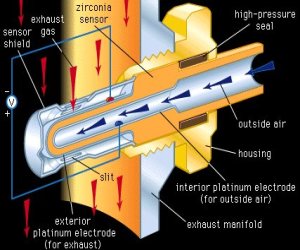Auto Oxygen SensorsWhen installing a hydrogen generator auto oxygen sensors play an important role with fuel injected vehicles. I hope by now we have all gotten past the idea in the HHO industry that you can use oxygen extenders on your O2 Sensors to adjust your vehicle's computer. Yes, Good! Automotive oxygen sensors are commonly referred to as O2 sensors. Oxygen atoms always travel in pairs thus the name "O2" which is the chemical formula for oxygen. They make modern electronic fuel injection and emission control possible. Auto oxygen sensors have been used on passenger car and light truck exhaust systems, here in the United States, since 1980-81. However Bosch O2 sensors came out in 1976 but were only used on Saab and Volvo. O2 sensors are astonishingly rugged considering the operating environment they exist in. They are continuously exposed to harmful gases and tremendous heat. The oxygen sensor is located on the exhaust manifold and/or exhaust pipes that lead to the muffler. What Auto Oxygen Sensors DoOxygen sensor measures the amount of the oxygen in the exhaust gases. The oxygen sensor has to precisely check this red-hot exhaust hundreds of times per minute and send that information to the vehicle computer. By measuring the amount of oxygen in the exhaust, the oxygen sensor can tell if your engine is running lean or rich and tells the computer to make changes accordingly. How Auto Oxygen Sensors WorkOxygen sensors work by burning some of the unburned oxygen in the exhaust, producing voltage, which varies by the percentage of oxygen in the exhaust, thereby telling the computer how rich or lean the mix is.Different fuels have different perfect ratios, the ratio depends on the quantity of carbon and hydrogen in a given amount of
fuel. When the O2 sensors fail the
computer can no longer sense the air/fuel ratio and will end up guessing and your vehicle will run inadequate and use more fuel.
Checking Your Auto Oxygen SensorsAn oxygen sensor's performance can be checked by reading the sensor's output voltage to make sure it corresponds with the air/fuel mixture. An oxygen sensor will typically generate up to about 0.9 volts when the fuel mixture is rich and there is little unburned oxygen in the exhaust. When the mixture is lean, the sensor output voltage will drop down to about 0.2 volts or less. When the air/fuel mixture is balanced or the equilibrium point of about 14.7 to 1, the sensor will read around .45 volts.Closed loop is the operating mode where all engine control sensors including the oxygen sensor are used to get best fuel economy, lowest emissions, and good power.The circuit stays in closed-loop and the logic module will still observe the oxygen sensor signal and allow the engine to run rich, but prevent it from running lean. Open loop is referred to when no signal is received from the O2 sensor, because no input is used from the O2 sensor to regulate the fuel mixture. Once the oxygen sensor detected that the mixture is lean or rich, it will send a voltage signal to the engine management ECU computer, which in turn issues a command to the mixture control solenoid found in the carburetor to adjust the mixture before it enters the engine. Types of auto Oxygen SensorsNewer cars (1990s and newer) have at least two oxygen sensors, "upstream" and "downstream," one of which provides the engine with its information, while the other provides a reference signal so the computer knows if the first sensor is going bad. With all 1996 and newer vehicles, the O2 sensors have doubled. A second oxygen sensor is now used downstream of the catalytic converter to observe converter operating efficiency. On V6 and V8 engines with dual exhausts, there are up to four O2 sensors, one for each cylinder bank and one after each converter, may be used. Basically there are 2 different types of auto oxygen sensors narrow band and wide band. Narrow band is more commonly found on vehicles today. The wide band O2 Sensor under a lot of opinions is superior to narrow band and may become the norm in the future. These devices also have a totally different method of talking to the ECU. Narrow band sensors communicate their information by providing a voltage that is read by the ECU. A wide band oxygen sensor uses a current flow, the strength of which is directly proportional to the amount of oxygen present in the exhaust stream. It is very exact. Additionally, the current flows one direction when the mix is lean, and other way when the mix is rich. It's for this reason that you can't use narrow band style EFIEs on wide band oxygen sensors. You need to use one that is designed to control current rather than voltage. To help find out which one you have to evaluate the electronic fuel injection enhancer you need for your hydrogen generator system please see our EFIE page. Problems With O2 SensorsRemember, a trouble code stored in the engine computer doesn't necessarily tell you what's wrong. That was because an oxygen sensor can't produce and send the rapidly toggling voltage signal the engine computer is expecting until the sensor is really hot (above 600 F).The performance of O2 sensor does diminish with time. They will become sluggish and not react to changes as they should causing emissions to go up.
Replacing Auto Oxygen SensorsAn EPA study found that 70% of the vehicles that failed a I/M 240 emissions test, needed a new O2 sensor.Auto oxygen sensors on 1976 through early 1990's should probably be replaced every 30,000 to 50,000 miles. Mid 1980s to 1990s every 60,000 miles. On 1996 and to present it is recommended to replace them every 1000,000 miles. Oxygen sensor replacement can range from easy to very difficult depending on where it is located. Removing an oxygen sensor from the exhaust manifold can be done with a unique oxygen sensor socket or a 22mm socket. The oxygen sensor socket should be placed over the sensor and turned counterclockwise to loosen. It comes off easier if the engine is a little warm. If frozen, apply penetrating oil and warm the base of the sensor. An OEM oxygen sensor will not need any modification. If replacing with a universal oxygen sensor, the O2 sensors must have the same number of wires as the original, and have the same internal resistance. The original wiring connector will have to be cut off so the wires on the new sensor can be spliced to the wires that went to the connector. With 4 wire sensors, one wire is the signal wire, one is ground, the other two are for the heater circuit. The wires are color coded, however the wires on the universal sensor probably won't match those of the original O2 sensor. Most replacement sensors come with anti-seize compound (the greasy silvery material on the threads) already applied, but if not, put a small amount on. In some cases the computer will say the downstream sensor is bad when actually the upstream has gone bad. All it knows is that the two differ, though usually it can figure out which is the faulty one. Cost To Replace Auto Oxygen SensorsAuto oxygen sensors prices are all over the board. You can usually save money with an universal sensor. Maybe the better question is how much is it costing you not to replace them? The benefits of replacing an O2 sensor periodically as preventative maintenance can restore fuel competence, minimize exhaust emissions and extend the life of the catalytic converter. |
|
|
|
Search This Site
541-846-8007
Email:hho@hydrogen-generators-usa.com
|
||
|
541-846-8007
Hydrogen-Generators-USA.com Copyright© 2008-2023 Hydrogen-Generators-USA.com - All Rights Reserved | ||
 If there is less air than this perfect ratio, there will be fuel left over after combustion this is called a rich mixture. A rich mixture is bad because the unburned
fuel creates car pollution. A lean mixture is caused when there is more air than this perfect ratio, this can cause poor performance.
If there is less air than this perfect ratio, there will be fuel left over after combustion this is called a rich mixture. A rich mixture is bad because the unburned
fuel creates car pollution. A lean mixture is caused when there is more air than this perfect ratio, this can cause poor performance.







